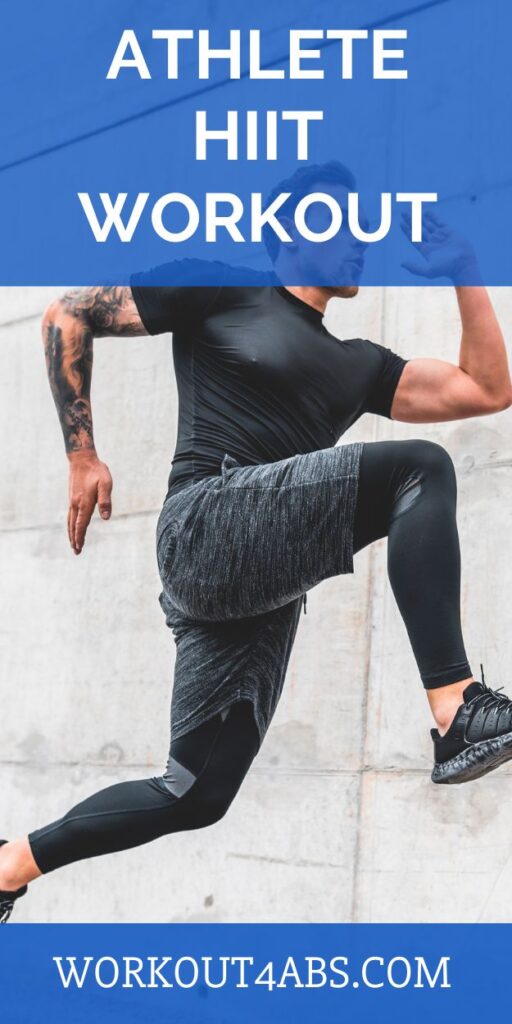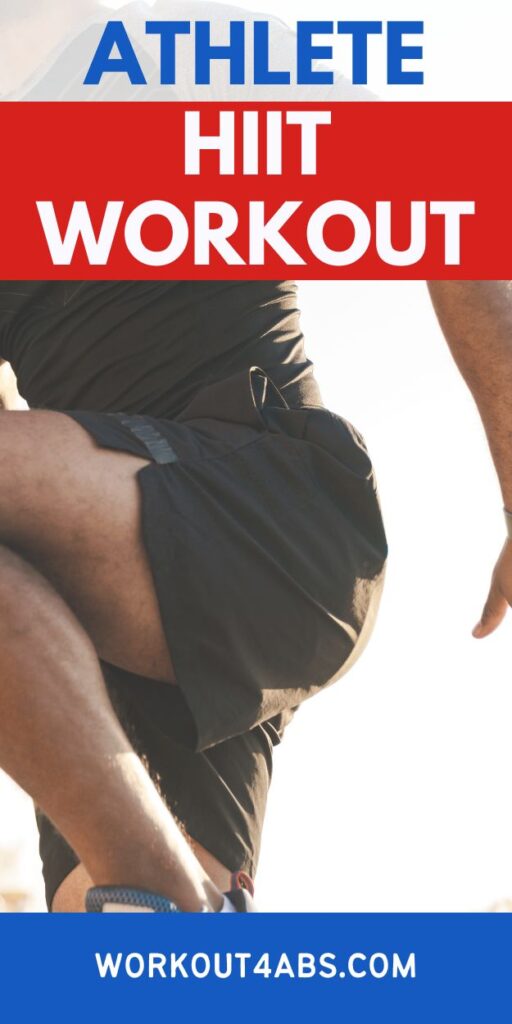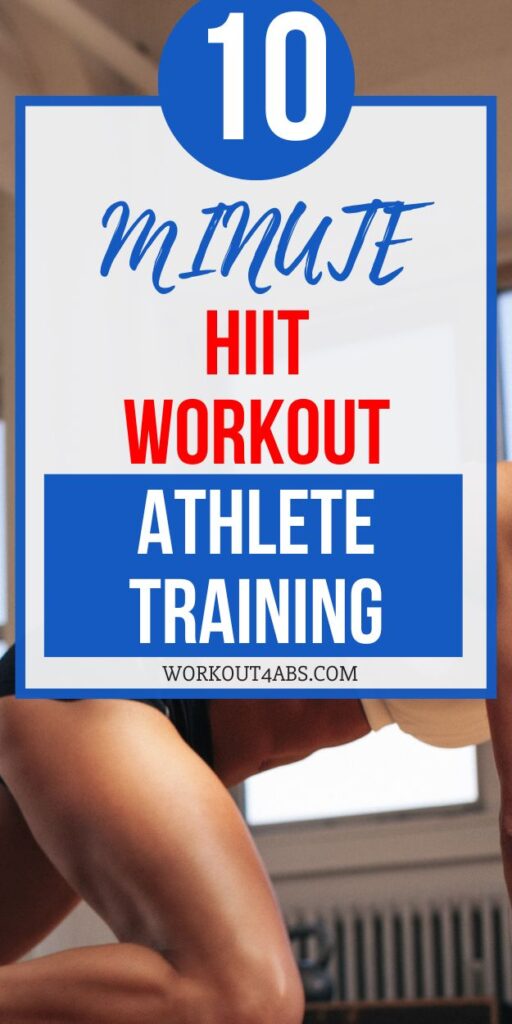Here’s your solution to an athlete HIIT workout. In the world of athletic performance, precision is paramount. This article unveils a high-intensity interval training (HIIT) regimen meticulously designed to elevate athletes to their peak potential. Discover the tailored exercises, intense intervals, and strategic recovery that constitute an athlete’s HIIT, delivering a competitive edge that sets champions apart.
10 Minute Fat Burning HIIT Workout – Become An Athlete
If you enjoyed these tips, please save this pin to your Pinterest Board.

Workout Exercises
Here are instructions for each of the exercises.
- Lateral Knee Drive:
- Stand with your feet hip-width apart.
- Lift your right knee toward your chest while simultaneously bringing your left elbow down towards it.
- Return to the starting position and repeat on the other side.
- This exercise works your obliques and improves balance.
- Skaters:
- Start by standing with your feet hip-width apart.
- Jump to your right while simultaneously crossing your left leg behind your right leg and swinging your left arm across your body.
- Land on your right foot and immediately jump to your left, reversing the motion.
- This exercise improves cardiovascular fitness, agility, and leg strength.
- 4-Step Plus Press-Up:
- Begin in a high plank position with your hands shoulder-width apart.
- Lower your chest to the ground in a push-up motion.
- Push back up to the plank position.
- Then, step your right hand and right foot out to the side, followed by your left hand and left foot.
- Step your right hand and right foot back to the center, then your left hand and left foot.
- Repeat the push-up and lateral stepping.
- This exercise targets your chest, shoulders, and core while also working on stability and coordination.
- 3 Squats Plus Butt Kick:
- Start with your feet shoulder-width apart.
- Perform three standard squats, lowering your hips back and down as if sitting in a chair.
- After the third squat, transition into a butt kick by kicking your heels up towards your glutes.
- This exercise combines lower body strength and cardio.
- Sprawl Plus Fast Feet:
- Begin in a standing position.
- Drop into a sprawl by placing your hands on the ground and kicking your feet back into a plank position.
- Quickly return to a standing position and perform fast feet, running in place as fast as you can.
- Repeat the sequence.
- This exercise improves cardiovascular fitness, agility, and works your entire body.
- Lunge Pulse Plus Knee Drive:
- Start by standing with your feet hip-width apart.
- Step your right leg back into a lunge position.
- Pulse up and down slightly in the lunge.
- After pulsing, step the right foot forward and drive the knee up towards your chest.
- Repeat on the other side.
- This exercise targets your legs, especially your quads and glutes, and also engages your core.
- Hollow Crunches:
- Lie on your back with your legs extended and your arms stretched overhead.
- Lift your legs and upper back off the ground, creating a “hollow” shape with your body.
- Engage your core muscles and crunch up, bringing your hands toward your feet.
- Lower back down to the hollow position without letting your lower back touch the ground.
- This exercise works your entire core.
- Spider Climbers:
- Start in a high plank position.
- Bring your right knee towards your right elbow while keeping your foot off the ground.
- Return your right leg to the plank position and repeat on the left side.
- Alternate between right and left.
- This exercise targets your core, shoulders, and hip flexors while also improving stability and coordination.
Remember to warm up before performing these exercises and consult a fitness professional or physician if you have any pre-existing medical conditions or concerns about your fitness level.
If you enjoyed these tips, please save this pin to your Pinterest Board.

Athlete HIIT Workout vs Regular HIIT Workout
High-Intensity Interval Training (HIIT) can be tailored to suit the specific needs and fitness levels of individuals, including athletes. The primary difference between a HIIT workout for an athlete and a traditional HIIT workout lies in the level of intensity, exercise selection, and training goals. Here’s a breakdown of the distinctions:
- Intensity Level:
- Athlete’s HIIT: Athletes are often accustomed to high-intensity training as part of their sport-specific conditioning. Therefore, an athlete’s HIIT workout may involve even higher levels of intensity compared to a traditional HIIT workout. The intervals may be shorter and the work/rest ratios more aggressive to challenge an athlete’s performance and conditioning.
- Traditional HIIT: Traditional HIIT workouts are designed for individuals of various fitness levels, including beginners. These workouts typically involve high intensity but may have slightly longer work intervals and more generous rest intervals compared to an athlete’s HIIT. The intensity is still high, but it is adapted to accommodate a wider audience.
- Exercise Selection:
- Athlete’s HIIT: Athletes often incorporate sport-specific movements and drills into their HIIT routines. For example, a sprinter might include sprints as part of their intervals, a basketball player might incorporate agility drills, and a swimmer might use swim sprints. The exercises are directly related to their sport to enhance performance.
- Traditional HIIT: In traditional HIIT workouts, the exercise selection is more general and can include bodyweight exercises (e.g., burpees, jumping jacks), strength exercises (e.g., kettlebell swings, squats), or cardiovascular exercises (e.g., cycling, running). The goal is to improve overall fitness and burn calories.
- Training Goals:
- Athlete’s HIIT: The primary goal of an athlete’s HIIT is to improve specific aspects of athletic performance, such as speed, agility, power, and sport-specific conditioning. These workouts are often integrated into their training programs to complement their sport-specific skills.
- Traditional HIIT: Traditional HIIT workouts are commonly used for general fitness goals, including fat loss, cardiovascular conditioning, and muscle endurance. These workouts are versatile and can benefit individuals with various fitness objectives.
- Recovery and Periodization:
- Athlete’s HIIT: Athletes often follow periodized training programs that include different phases of intensity and recovery. Their HIIT workouts may be strategically placed within these training cycles to ensure they peak at the right times and minimize the risk of overtraining.
- Traditional HIIT: While recovery is essential in all types of HIIT, traditional HIIT may allow for more flexibility in terms of frequency and timing. Recovery periods are typically provided to allow participants to catch their breath and perform at a high intensity in subsequent intervals.
In summary, the difference between a HIIT workout for an athlete and a traditional HIIT workout primarily lies in the level of intensity, exercise specificity, training goals, and how they fit into an individual’s overall training program. Athlete-specific HIIT is tailored to enhance sport-specific performance, while traditional HIIT is more broadly focused on fitness and conditioning.
If you enjoyed these tips on athlete HIIT workout and would like to keep it close to you at any time, just save this pin to your Pinterest Board.

Home › Workout for Athletes ›Athlete HIIT Workout